CAVING, CAVE DIVING AND MOUNTAINEERING
I have started my life with caves in mountainous areas. Before I continue to tell that underground life, it is interesting to develop the common points and differences of caving and mountaineering. Strong oppositions can exist between the milieu of mountaineering and the one of caving regarding motivation, engagement and other aspects. I succeeded to escape this duality by retaining only what I found interesting in each practise. ‘Take the best and forget what remains’ took me a lot of time and of reflection; what follows is a part of these thoughts.
The inner parts of most mountainous massifs correspond to deep igneous or metamorphic rocks that have been strongly up-heaved and broken. The Mont Blanc and Aiguilles Rouges in France are good examples (Picture 4.1). These are the highest and snowiest ranges that are very interesting for mountaineers who often don’t afford interesting caves. On the opposite, some karstic areas are located at low altitude inland or on coasts. When they have less relief and are devoid from snow at any season, they cannot be regarded as true mountainous areas despite their a strong interest for cavers. However, the realm of caves and karsts and the one of mountains and cliffs overlap. A lot of karsts develop in mountainous areas or in foothills. The outer parts of many massifs correspond to sedimentary rocks, including limestone. During upheaval, they have been folded just as required for cave formation.
In addition to limestone or similar rocks, cave formation (in other words: karstification) needs fracturing, water and height for the water to move through the fractures. The main mechanism of cave formation is the enlargement of permeable joints, cracks and bedding planes by water circulating inside. Regarding this fluid, when wet air arrives on mountain ranges, the moisture condenses because the altitude increases. It corresponds to more important rains or snowfalls; then, cave evolution can be enhanced in some massifs. In addition to deep and numerous pits, this can be one of the multiple reasons to regard them as cavers’ mecca. This is the case of the Chartreuse we met in the previous chapter. In order to reach caves in mountainous areas, overcoming obstacles often needs basic mountain techniques. Walking outdoors for a long time on step tracks or dealing with snow is something current. So sharing a common landscape is a first relationship between caving and mountaineering (Pictures 4.2 to 4.4).
In order to reach caves opening in cliffs, it can be necessary to climb or to abseil. As a consequence, more technical common points exist. Sometimes one has to rely entirely on a rope. This is a complete similitude only for non-specialists. Ropes are mainly used in caves in order to drop down or to ascend pits. This means that without the rope nothing is possible. On the contrary, when climbing or mountaineering, the rope is often a safety item (Picture 4.1 and 4.5). With a higher risk and the corresponding greater engagement, things would remain possible without it. The same kind of shallow similitude exists with more technical gears. A lot of very frequented routes as well as a lot of very frequented caves are equipped with bolts (artificial anchors); then finding one’s way becomes very easy, and the equipment is easier. However, the bolts of a route are devoted to protect falls, whereas in caves they have a different position and orientation that allow an easy descent or ascent without rubbing. Confusing both notions has led to very bad equipment in some caves, at least in my country. Regarding less-frequented routes or caves, especially during the first incursions, chocks and nuts can be used in addition to natural anchors. They need more knowledge, but it spares time and effort if you master things. Once again, those anchors have not the same function in a cliff and underground. The fashion to install them and the directions of the forces they have to resist are different. According to my own experience, appropriate places for nuts are scarcer underground, but once installed, it is easier to understand whether they will be safe or not. Climbing inside a cave is very different from climbing a slab or another part of a route. The environment of a cave is often confined and slippery. Those who climb will understand that the concept of adherence is less useful and the concept of opposition is more interesting. Sometimes the problem is not a possible fall but how to avoid blockage in narrow sections even if they are vertical. Progression in parts of caves where no ropes are needed has more to do with scrambling than with extreme climbing. All these technical relationships can explain why cavers and mountaineers don’t always regard engagement and risk in the same fashion. A part of the risk is linked with material and people whereas another isn’t. The surroundings being different, these objective risks are different too (Pictures 4.6 and 4.7). Underground surroundings are more stable than mountainous surroundings because the time scales aren’t the same. Underground, one can be exposed to rises, falling slabs and other difficulties; but risks such as avalanches and stones suddenly falling at dawn or later because of warming almost vanish.
Another relationship exists, devoid of material basis: in addition to the acceptance (or not) of certain vital risks, there can exist common aims or feelings. It depends more upon the character of the person doing things. I will develop below what concerns exploration and première. Here, I just want to point out that some people practise exclusively mountain activities or do only underground activities. Others practise both. They regard them as complementary, as in continuity; they look for technical and human enrichment. This is my case. I don’t regard myself as a complete and skilful mountaineer, but experiencing some problems outside caves helps me to balance the underground problems I have to solve. Then I practise mountain ski and climbing, sometimes with my friends and sometimes alone. Some mountaineers never practise caving because they don’t like the environment, which is too much dark, muddy and restricted. Even if not really claustrophobic, they need sky, wind, sunlight and other things, which disappear underground. For them, cave diving is the worst, and they regard it as something morbid or crazy. My opinion is beyond the duality: if you cannot have sunlight and blue sky underground, it enhances the pleasure to feel them anew once outside the cave. When underground, one can remember these essential elements of nature; it enhances them. Some other elements such as water, wind and sand can be found underground. Reaching a small beach or experiencing spindrift very far from the sea is very poetic.
In addition to space scales, time scales are not the same inside and outside caves. Mountaineers need to wake up very early in order to avoid snow melting and other problems. One can spend several days of bivouac without any problem even in wintertime. On the contrary, bivouac is difficult underground and must be avoided. Caving implies to accept to come back very late; an incursion that has begun during the day may not end before the next morning. Despite the common landscape evoked above, surroundings are different too. Differences arise regarding motion, rescue, survey and the notion of exploration itself.
Foremost, helicopter, cordless phone, GPS, and other technological wonders of the last 60 years cannot enter underground. The degree of insulation remains higher underground than in mountains even if one takes into account Himalayas, Cordillera, Antarctica and other remote ranges. Even if subjected to a certain kind of technology and helped by it—cordless rotary hammer, for example—a rescue underground remains a purely human operation. To a certain extent, it is something external to caving, for it has another goal. The aim is to save lives and no more to do pure exploration. It requires an organisation and resources that are by far more extended than those of caving. The use of technological resources is possible only in a limited fashion and always comes up over strong obstacles. For instance, it is possible but uneasy and very expensive to bore an artificial shaft for a rescue beyond a series of sumps or beyond very narrow parts. From this point of view, cave rescue can be compared to mountain rescue before the fifties. A lot of mountain accidents, even the most severe, are quickly solved directly by helicopter, and the victim is quickly brought to a doctor. Underground, a doctor who is also a good caver is warmly welcome, for it is easier to bring the doctor to the victim. In case of a serious accident, the possibility of an operation underground cannot be excluded with all the difficulties and risks it implies. This suggests to a certain extent that even if caving is less subjected to objective risks than mountaineering, it is more subjected to the necessity of avoiding any risks.
The climbers who have climbed for the first time an exposed and complex face have often used photographs of this face. This enables to trace the route and to have a minimal mental representation of the obstacles before climbing. The history of the three last problems of the Alps (Cervin’s north face, Grandes Jorasses and Eiger’s north face), particularly the latter, is a good example. Caving exploration has often to do things without such hints (Picture 4.8). Of course, satellite or aerial photography is used in order to find shafts and other cave entrances each time it is possible. Of course, once the surveyed exploration has begun in a cave, it is possible to look at the existing survey or to superimpose it on a surface map in order to conjure possible continuations. But at the present time, there is no efficient means to have a direct image of underground networks before exploration. This is why making surveys is so important. In the best case, it is only possible to use geological clues viewed from the surface in order to guess what could be the limitations imposed on galleries’ development. The hypotheses have to be verified by a thorough underground exploration. One of my explorations has almost entirely been devoted to this kind of ‘theoretical caving’. I spent more time to reflection and outside observations than to dive in the cave in order to conclude it had probably no interesting continuation. All what concerns the Source Bleue de Cusance is developed in chapter 13.
A mountain has a summit, which can very often be reached by several routes. They can be ‘easy’ or ‘difficult’. So in the realm of mountaineering, a route or a face is something different from a summit. Reaching a summit by its easiest route or by its most difficult one has not the same meaning at all. Underground, one must realise that a cave, which is perhaps the equivalent of a summit, represents only one route. Except in the case of complex networks having junctions, it is impossible to reach the bottom or the end of the cave by two or more routes. This defines one of the goals of caving, which has no equivalent in mountaineering: looking for the junction between close caves or between parts of a network that have not previously been humanly joined. This is very frequently a huge teamwork that extends over many dozens of years. My own opinion is that having several motivations is safer and more interesting.
Seasons don’t have the same importance for caves than for mountains. Except the walk for reaching the entrance or except if the bottom of the system is at the water table, a majority of fossil caves are quite independent of the seasons. Some tougher caves, especially sumps or networks having flooded pits, can be entered only during favourable hydrological episodes. Frequently, this is either during dry summers or during cold winters. On the opposite, a lot of mountain routes can be climbed during winter as well as during summer but with very different degrees of difficulty (Picture 4.9 and 4.10). This is probably the reason cavers who are still very attached to competitive values mix up première and high-level practise. Another reason is (or was, since 2008 we are in times of economic crisis) the fashion to get money from the federations or other official institutions in charge of caving and cave diving. The available amount of money is very limited. Then the expected quantity of première is often the most important criterion. Underground, the variety of fashions of doing things, the qualitative aspect doesn’t matter to the greatest number. I think that a kind of diversification appears only with the ethical limits a caver can impose to himself. In other words, I regard the milieu of caving as very late and conservative regarding other milieus. This is another reason for doing climbing and other mountain activities. I am very happy when I succeed to climb alone a small route which is difficult to me whatever its difficulty for other people (Picture 4.11).
Even if some 6,000-metre peaks still remain unclimbed in remote countries, almost all the classical alpine problems have been solved. Almost all the classical summits have been reached many times. This is not the case regarding sumps. Mainly due to the depth and decompression imperatives, a lot of sumps are well-known but unfinished. Their end, for instance a free surface or a breakdown, has not yet been reached. Frequently, a new progression of a few hundred metres is considered as a huge exploit and a big première.
I have made several kilometres of première in sumps and very few or not in mountains. But my own conclusion is that première and difficulty are not linked in a systematic fashion. Sometimes when I come back in some sumps where I made première, I find it less easy. With a friend we have perhaps done some première when mountaineering. We wanted to reach a summit, and we found a part of the classical route too hard because of the snow, so we improvised something else. In that case, doing première was not our aim. We just wanted to reach the summit and sky down another face. If I had an advice to give to someone it would be the following: première remains important but don’t focus on it. What matters is to acquire very large knowledge and to make new things.
In addition to what precedes, mountaineers and cavers have not the same point of view about available means. The means used for speleological endeavours are sometimes described in an incomplete fashion. For instance, the number of tanks and other heavy items needed to explore a sump is frequently reckoned, but a bookkeeping that would establish the part of personal resources really spent by the lucky winner is scarcely available. Another difference brings back to ethics or absence of ethics: very often, underground, all available means are used. This is different from mountaineering nowadays where one can, for instance, refuse to use artificial anchors. The fact that a lot of great sumps are today unfinished has an uncertain and dim meaning. It should mean that the underground world can provide problems having a higher grade of complexity than alpine problems. Or it should mean that underground explorations, on the contrary of the alpine ones, cannot be carried out at a really human level.
The relationship between caving and technology is not the same from the relationship between mountaineering and technology. As already explained, it is possible to enter mountains almost without technological objects whereas non-technological incursions in caves are very limited. It is true that high-level mountaineering depends upon technological objects, such as resistant ropes, friends, cams and ice tools. Nevertheless, it has a weaker need of technological objects than high-level caving and, foremost, cave diving. Reducing the number of technological items and their importance can be a goal in the alpine realm. It is also a goal for caving and cave diving, and this is the essence of ‘painless techniques’, also known as light techniques. But in caving and cave diving, the dependence upon technology will always remain more important. Even if nothing is explicitly said, a complex human organisation looms as a backdrop. As suggested above, it is virtually impossible to venture in a succession of vertical pitches without equipping them with ropes, whereas some long and difficult routes have been solo climbed without the use of any rope. Venturing in a sump longer or deeper than few metres requires the compulsory use of diving apparatus; a ‘free challenge’ in apnoea is virtually impossible. The use of oxygen is more emblematic. Climbing a route and reaching a high summit without oxygen has been and is still a valuable goal for those engaged into very high mountains. This is perfectly understandable from the point of view of painless techniques. It can spare weight, time, global exhaustion. In sumps, the same logic leads to the contrary. For instance, oxygen is used to enhance the quality of decompression stops and to reduce their length. Refusing to use oxygen and gas mixes in sumps would be nonsense and, to a certain extent, something opposite to any coherent ethical rule.
Being at the end of a complex human organisation appears also in the time scales. Some difficult routes have been created in a short time at the scale of a dozen of hours or less by a small team. It is also possible for a small team to travel in a complex cave at that scale of time. Once again, this is one of the goals of painless techniques. However, during the exploration of a new vertical cave, boring the holes needed for at least few artificial anchors and doing the survey would take more time. Underground exploration remains currently something slow and heavy. Even if it is split into many quick and light incursions, it remains a matter of carrying material using human means and it takes several days. It can be shortened by using a larger team. But in such a situation, it means that a more or less extended part of the team is just a crew that will not fully appreciate the whole cave. The cavers who carry the material but don’t dive are called Sherpas by cave divers. This word borrowed from the Himalayas speaks by itself.
Caving and cave diving remain more technological than mountaineering. It is more difficult to reduce the amount of material needed or the size of a team. Even if one wants to avoid the cliché of nature as opposed to the artificial world created by man, this difference exemplifies the fact that very few human projects are fully independent from the products and methods that prevail since the Industrial Revolution. Climbing requires violent efforts. Hiking requires huge continuous efforts whereas a trend of our civilised world is to avoid this kind of efforts. They are less required in caving and cave diving. When moving along a guideline, especially with the help of a propeller, one must be able to endure cold and other constraints of the surroundings; but one has not to deal with the very intense, precise and critical effort needed during climbing. When passing a critical section during climbing—for instance, a overhang—rest is impossible. It is always possible to stop along the rope when ascending a pit or to ascend at a slower pace. All these differences are reasons to find a balance between caving and other activities. However, inside the milieu of caving, differences are often concealed to such an extent that there is a problem. It is possible to believe that nowadays certain cavers have a problem with the mountain and a biased perception of its environment. Perhaps caving is for them a compensation for mountain activities they cannot do. I had myself some problems with the height and unravelling things has had a great importance. It has been a milestone on the way to understand the specificities, differences and common points of the environments of sumps, caves and mountains. It has led me to understand that being too much at ease can also be a problem. I have had trouble with ‘pure’ cavers and cave divers as well as with some mountaineers because they had a reduced point of view.
In the early times, several cavers were also good mountaineers. For instance, the Couloir Chevalier, in the Massif of Mont Blanc, is named after Pierre Chevalier, a brilliant caver and engineer. He was an Alpinist who led the underground explorations during the forties of the last century in the vicinity of Grenoble inside the massif of the Dent de Crolles. He contributed to the discovery and survey of important parts of the eponymous underground network. He was one of the first to think of using nylon to replace hemp ropes. Fernand Petzl, the creator of the well-known Petzl firm, was another prominent member of the team. They were the first to develop apparatuses devoted to single-rope ascent, although this technique originates very probably from a publication of the Spéleo Club de Paris (Paris Caving Club). This association depended on the French Alpine Club (Club Alpin Français or CAF). Another interesting trajectory is the one of the Italian caver Emilio Comici. He made several explorations in the Carso and other karstic areas. After that, he turned to climbing. He solo climbed the north face of the Cima Grande and made several remarkable routes with companions. However, he met a technical problem during a hard climb and accidentally died at the beginning of the forties.
In our time, as suggested above, it is more difficult (but not impossible) to find such people who were good mountaineers as well as good cavers. For a certain number of cavers, the use of the word alpine means the approach of the emptiness and vertical space firmly locked to a rope. This has superseded the approach of true various alpine surroundings. The title of a famous book written by French speleologists and translated into English as Alpine Caving Techniques is a clear example. At least in France, the term alpine techniques exclusively stands for the use of ropes and related material in order to descend and ascend into shafts and other vertical parts of caves. This is one of the proofs of the biased perception of some cavers I suggested above.
Another evidence is longer to show. On the one hand, those alpine techniques have a predominant part in people’s minds. They take a large place during instructor examinations and in curricula. In many writings, engagement underground is measured at the sole yardstick of equipment. Other facets of engagement are less taken into account. One must also have in mind the splitting of an original field into three parts. In my country, caving, canyoning and cave diving are taught in a separate fashion. If canyoning and cave diving are taught apart, it means cavers are assumed to be able to cave without a high knowledge of water. Regarding caving, less time is devoted to the approach of water underground than to the approach of height. The approach of height is regarded as more important than the approach of digging and prospecting. Firm knowledge in karstic geology and hydrology is not always regarded as a necessary basis. On the other hand, this strong emphasis put on height contrasts with facts. Numerous cavers are not at ease in vertical surroundings. Often, bolts and other man-made anchors are not found at the best place or with the right orientation, and this is a material evidence of this assertion. The tardiness of some incursions can be regarded as an incident. Together with accidents not having an objective cause, it suggests that many cavers have not the physical condition needed to be a mountaineer even at a modest level.
During some climbing situations, a rope could be easily broken by an important shock, for instance, if you fall from an important height below the last anchor. The anchors may also be damaged by the shock and break. Shocks cannot be totally avoided during climbing or mountaineering, and this is why certain situations need a great care. For instance, it can be necessary to practise ‘dynamical belay’ to stop very progressively someone who is falling. Nevertheless, a lot of cavers fear ‘the shock that could damage the equipment’ in situations where shocks cannot exist. I should write ‘shouldn’t exist’. A shock underground can happen only with a wrong equipment or a wrong fashion to use it. I have encountered a lot of problems when dealing with very dogmatic and narrow-minded people unable to have a proper view of this problem. I could even write it has shaped my underground career as it will be developed in several further chapters.
Cave diving uses guidelines in place of ropes. It has a special position regarding the whole caving, not only because of this detail. From the classical point of view of pure exploration and pure première, it allows more solo practice. Even if the preparation is a teamwork, the final dive by itself is often the work of only one man. Cave diving is also more engaged than dry caving. Venturing in a cave with the right degree of preparation has a very low level of risk even if the cave is a very vertical one. For example, with a right equipment, the probability for breaking a rope is null. Cave diving has a higher level of risk. A part of it corresponds to the management of gas autonomy and safety margins. Playing with words, one must be exactly at the watershed. On the one hand, too-important safety margins would not allow the maximal possible incursion. They would lead to several dives where only one is enough; hence, they would enhance global risks. On the other hand, too-restricted safety margins would not allow to come back to the exit in case of problem and would surely lead to a painful death. Another part of the risk corresponds to the physical form of the diver. A cramp or a too-important cooling far from the entrance could also lead to death. There exist special risks such as the fall of a slab or the collapse of a breakdown.
Because of these objective risks, I regard now cave diving (at least the cave diving I do) as something very close to the climbing and mountain ski I can do. The level of engagement and risk are the same, and the same kind of physical violence I like is present. Of course, this violence is oriented towards nobody. The proximity has also something to do with the use of a rope for climbing and the use of a guideline for diving into a cave; your life strongly depends of the continuity of this item. It is not obvious to realise. On the one hand, because the absence of verticality, some problems can develop very slowly during cave diving. For instance, a tank is not open at the beginning of the dive, and the problem is revealed one hour after in an emergency situation where that tank is needed. On the other hand, problems develop very quickly in vertical activities. For example, if one slips during climbing, the fall is immediate. This is the same thing if you fall when skying a steep face. However, the guideline used underwater is something quite fine, and it may break due to rubbing or tension (mistakes). This is the same problem with a rope breaking after a fall (another mistake). I have found the same problems of autonomy, the same necessity of good physical form, the same kind of engagement, and also the same use of items at their limit. The human constraint can be released by solo practice in both kinds of activities. The only difference remains the aforementioned technological constraint; even when diving alone far underground, I’m depending on a remote but huge technological world. Petrarch, who didn’t live in our technological modern age, has explored the Mont Ventoux, which is a mountain, but not the Fontaine de Vaucluse (Vaucluse’s Spring), which is a sump. Reaching certain places alone, with a great amount of effort and/or risk, gives the beauty one finds there (Pictures 4.2, 4.3, 4.4) an additional significance and an additional value.
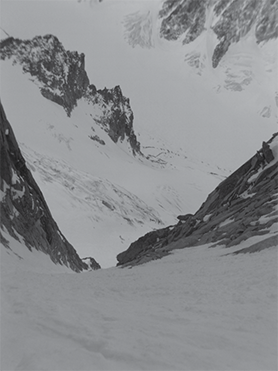
Picture 4.1: Solo mountaineering inside the Couloir en Y (“Y Gully”) of the Aiguille d’Argentière, near Chamonix (France, department of Haute Savoie). With my friend Stéphane Delcausse we went here a first time and he was the leader. Two years later I went alone a second time. Things are more engaged than dropping down pits alone. Using a rope would be too much difficult and one must engage oneself only if one is sure to cope with all possible difficulties. After reaching the summit, one can sky another face of the Aiguille d’Argentières which has a step of about 40°.
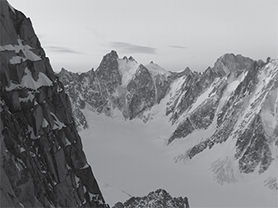
Picture 4.2: Another common-point to mountains, cliffs and karstic places is that they afford gorgeous sights… Here it has been a pleasure to slowly climb and appreciate the dawn, the dark sky has slowly turned to blue and several rose and orange tinges have appeared and then disappeared.
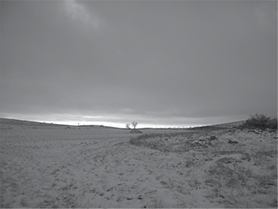
Picture 4.3: Another common-point to mountains, cliffs and karstic places is that they afford gorgeous sights… Orange dawn on a Causse (limestone plateau) during a cold windy wintertime.
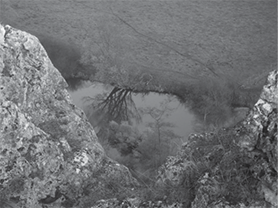
Picture 4.4: Another common-point to mountains, cliffs and karstic places is that they afford gorgeous sights… This limestone cliff affords all the elements for karstification (water, rock, difference of height) even if it has no caves. At least a reflection on the water enhances the timeless landscape one can see when climbing.
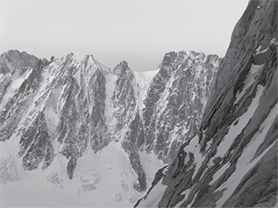
Picture 4.5: At least with a good weather, the sight when climbing a mountain is always very beautiful, sometimes startling. On the contrary of caving, not all the things are hidden and it is possible to perceive the whole scenery. Here, the perspective enhances the verticality of the foreground, sometimes it is the opposite situation.
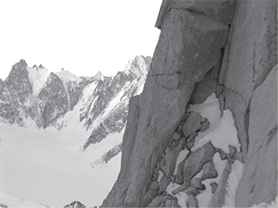
Picture 4.6: Rock is often more broken on the slope of mountains than underground, in caves. There are also snow and ice which can melt and let escape blocks on an unlucky mountaineer. To a certain extent, the mountainous environment has more objective dangers than the underground environment, itself not devoid of objective dangers.
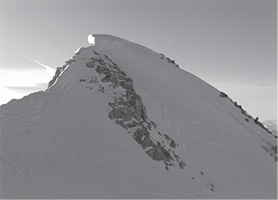
Picture 4.7: Another danger of the mountain. This snow overhang can break and fall with you. The well known German mountaineer Hermann Bühl is dead in 1957 near the summit of the Nanga Parbat because of such a problem.
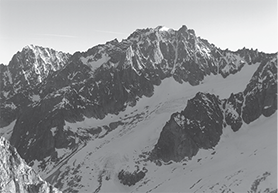
Picture 4.8: The Couloir en Y is perfectly visible (below the highest snowy summit) from the Col des Cristaux (“Crystals saddle”) where I went the day after Picture 1. If it were a première to do, photographs could be made and studied before climbing. That is perfectly impossible underground, the survey is always made afterwards.
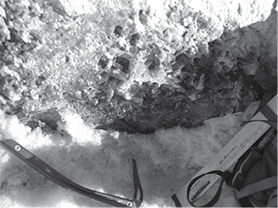
Picture 4.9: The Col des Cristaux gets its name from the nice crystals one can find if one is lucky. Mineral wealth is a common-point to caves and mountains, being in love with minerals, rocks and geology can be a reason to practise these outdoors activities. In addition, skying here is an interesting problem.
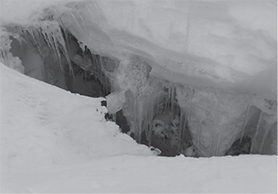
Picture 4.10: The bergschrund (ice crevice in the border of the glacier) below the Col des Cristaux. If you fall when skying above, there is a risk to disappear in this bergschrund. Larger and nicer crevices can be explored in the same fashion than limestone pits, the bolts are replaced by ice screws. The opening of such voids and the presence of snow enough to sky is very variable according to the seasons.
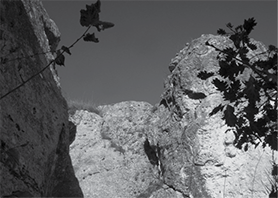
Picture 4.11: Some limestone cliffs are very interesting to climb as a training (here the Falaise de Surgy, in the French department of the Nièvre). This isn’t only a practise of climbing for itself, but also a fashion to keep in contact with height and physical efforts when one cannot do enough caving. Reciprocally, a caver must have firm knowledges about climbing.